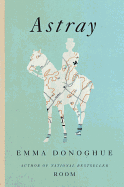
Emma Donoghue's Astray contains 14 stories inspired by events and personages of the past, most drawn from the 1800s. Fans of Room will recognize the same imaginative flexibility and ventriloquism in Astray. As befits their period, the fictionalized accounts have a stereoscopic, peering perspective, yet they do not read as stiff or fixed. Donoghue's close focus on her characters' yearnings and her respect for pivotal consequences transcend old-timey reenactment. She also avoids research-larding in spite of what appears to be a deep fluency with matters as arcane as Yukon gold miner libations (hootchinoo, anyone?) and the laws concerning body-snatching in 19th-century Illinois. At the end of each story, Donoghue appends a précis that makes clear what she borrowed and what she invented.
Conjuring period slang and attitudes to animate characters as diverse as a 1630s Puritan snitch and a 1960s retired Ontario sculptress is a tough exercise, and Donoghue's interior monologues and verbal exchanges enhance the immersive effect. The first story is an imagined transcription of Jumbo's London trainer coaxing the famous elephant through some hard transitions; it's as tender a bro-pachymance as you'll find in words. Many of the stories reveal the moral ambiguities of survival and reinvention; others remind the reader of how precarious travel and communication were in pre-digital times.
Though the stories are arranged under thematic headings ("Departures," "In Transit," "Arrivals and Aftermaths"), Astray is a refreshing break from the trend of linked collections; each story is entirely discrete, and strong enough to be read in isolation. --Holloway McCandless, blogger at Litagogo: A Guide to Free Literary Podcasts

